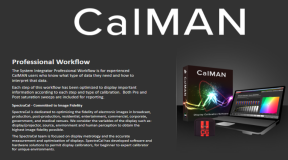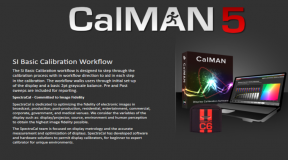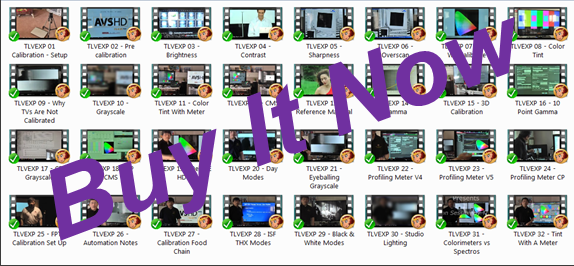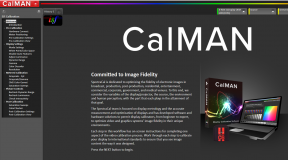A calibrator comes to your home in the day time, regardless of lighting conditions or even if you are home or not. His wife or housekeeper lets him in and he only has 80 minutes to work on your TV before he has to be on his way to the next home. Unpacking and set up of his gear and break down of the gear will take about 20 to 30 minutes. All told, he has 50 to 60 minutes of real time to actually do the calibration on your TV.
He doesn’t have time to survey how your gear is connected to the display and out comes your HDMI plug on the TV and in goes his signal generator. He is off to the races and the TV is calibrated for grayscale. Time to head off to the next appointment.
 He never gets to see programming material or talk to anyone about what he did to the display or explain why. He’s out of the house and on his way to the next job – the TV is calibrated. When you get home, someone tells you that the TV guy was here and you turn on the TV. It looks different than it looked yesterday. More yellow … and dimmer too. The image actually looks softer as well … possibly more blurry …
He never gets to see programming material or talk to anyone about what he did to the display or explain why. He’s out of the house and on his way to the next job – the TV is calibrated. When you get home, someone tells you that the TV guy was here and you turn on the TV. It looks different than it looked yesterday. More yellow … and dimmer too. The image actually looks softer as well … possibly more blurry …
You pick up the remote and look at TV picture modes and select Dynamic … the bright picture you had yesterday is back … now you wonder why you paid that money for a “calibration.” This result is clearly worse than what you had. You will chalk it up to a hard lesson learned … or you will go back to the box store and tell them you want a refund on the service.
A few of your friends ask you how that “calibration” thing turned out. Not surprisingly, you say that it was a complete waste of your money and the results were worse than when you started. Your friends will now be weary of calibration too. It’s a scam after all.
In a perfect world, you pay for a service, it gets performed to the desired result and you are happy. It doesn’t matter if it takes five minutes to achieve that result or five hours. You are paying for a person’s experience and not how long he spends in your home. Unfortunately, we don’t live in that perfect world …
In the above described scenario, which is repeated many times on a daily basis around the country, even the best calibrator in the world, doing a world class job would end up with this same result. Something is missing from this formula. Clearly, just delivering a competent calibration job is not enough here.
This leads to the following statement …
“The answer is 4!!”
Does someone want to venture an opinion about what this statement means? This gets asked at every THX Video Calibration class and no one even comes close (they don’t ask this in ISF classes… for other reasons).
What more do you want? I’ve given you the answer. That is all that you need. Calibration of a display provides answers. God ordains that once you have an answer, you will automatically love it … well, er … knowing what the question is might help …
This leads to another story that happened sometime in the 2004/2005 time frame. I had a client with a 65″ Hitachi RPTV that was both ugly looking in terms of colors and needed geometry and focus work. Coming in and seeing the state of his television, I figured that this was going to be a six hour job. Lots of physical things to do to the TV and also talk with the client. As I do my set up, the client informs me that he has tickets to a local car show and he will not be around for the calibration. But that is okay with him so he leaves the money on the table and tells me to just lock the door on my way out.
At this point in time, I would always try to educate my clients, but for those that simply could not sit through it, I figured that it was their loss and would continue with the calibration itself. With the client gone and the house empty, the six hour calibration job is reduced to 2.5 hours. There is no one to talk to except the wall and so the TV gets calibrated. I am happy with the results as my reference material looks exactly the way I expect it to look and it is time to go home.
The nightmare scenario begins when the client gets home later that day. It turns out that he has two other TVs in his home and he did not ask me to calibrate those sets. I don’t even know that those displays exist in his home. It doesn’t take the person long to realize that the main display, the 65″ RPTV, now looks very different than his two other TVs. His two other displays are not calibrated and are still at factory default settings like sports mode and vivid mode (modes that are also lovingly referred to as “Torch” modes). He has come to the conclusion that I have actually ruined his TV set and he feels that I have to buy him a new one.
It gets worse … the man is also a heavy drinker.
It is 12:30 AM Sunday morning, and there is a message on my answering machine (the client was 220 miles away). It is the client and he is drunk and mad as hell. He tells me how I have wrecked his TV and how I now owe him a new one. He also then talks about having a “baseball bat” and how he will take care of me to make sure I cannot pull this scam, this con job on anyone else ever again. Hopefully sober people do not leave threatening messages on answering machines…it’s called evidence.
I try to contact the client the following week in an attempt to sort this out. He is still very angry and he will not hear anything that I have to say short of … “Yes sir, I will buy you a new TV set.” Since I don’t have a clear picture as to what is happening, I am not about to say that to the client yet. He gets abusive over the telephone and I hang up. In the following week, I contact his friend, who originally recommended my services to him, and ask him what is happening. Why has his friend gone psycho? He is at a loss for words. This is a part of that person’s personality that he has never seen before. By the second week, I contact the client again and this time he has calmed down. We make an appointment to take a look at the TV and when I get back there, the TV looks exactly the way I left it; not broken and not ruined.
I sit the client down and show him a test pattern. This is a pattern for setting brightness on the TV and explain to him how we do it and why it gets set this way. I do the same with a pattern for doing contrast…and then color and tint…etc. I then show him my calibration equipment and how it works.
Two and a half hours later of education, the client is happy. He is also very apologetic at this point because he realizes how badly he had behaved. The picture on the TV has not changed at all. It is still the same calibrated image that he was left with before. And people are always asking me whether I think they will like a calibrated image or not and whether they will see a difference. Well here was a shining example of a person that starts out hating the image and then mere hours later, loves the image despite the fact that the picture never changed.
This was my epiphany moment in calibration. It got me to realize that answers without the accompanying understanding portion meant nothing. Answers have no meaning or value if you do not understand the why part. For this client, the wrong answers that represented his two other TVs were deemed to be more correct than the correct answer was. Clearly, giving people a calibrated display and not educating them was not enough and accomplished little to nothing.
Two lessons were learned on that day.
1. Answers without understanding are answers without meaning or value.
2. This will not happen to me again.
After this incident, I altered the way that I do calibrations for good. Education became mandatory and no clients were permitted to opt out of this part. When someone wanted to opt out, I would decline the calibration job. I would not put myself (or my clients) in that position again and no job is worth that type of aggravation. Life is too short to have to deal with people like this. I’m happy to say that I have not had any client incident remotely like that since then.
A nice side benefit out of this which I had not foreseen at the time was that educated clients also talk to their friends. They can also speak intelligently about the process and they become advocates of the process and generate very positive word of mouth. They also become your recurring clients.
The typical response about what a calibrated TV looks like from someone that did not get an education is that “It looks kinda dark …” Will people be lined up to get your calibration services after a comment like that? Educated clients never say such things. It is like saying that “2+2=4” gives an answer that is a rather small number. “98” is much bigger … so maybe that is a better answer.
I tell my clients up front that my calibration sessions will last from 4 to 6 hours … sometimes longer. They know there is an education session as part of this and most look forward to it. There is no comparison between what I offer and what a big box store can offer. If a person still opts for the box store guys simply because they are cheaper, then it tells me that this person is willing to pay for something that they will not understand simply because it is cheaper. It’s a test of rational thinking and I don’t want irrational clients.
From a calibration perspective, those looking for the services of a professional calibrator need to ask themselves what they want out of the process.
The big box stores offer the hit and run service. A lot of independent calibrators offer a similar hit and run service because they simply don’t know any better and haven’t figured it out. THX Video Calibrators are taught that education of the client is paramount in the process. But will those same THX calibrators practice what was taught? Some do, and some don’t. I know of a small handful of calibrators that do this. (Check out the TLVEXP Portal on the menubar for a list of these calibrator guys.) ISF calibrators are definitely not taught this aspect of calibration at all. I wish I could be more helpful to those looking for a qualified professional. If I were to proffer one piece of advice, it would be to ask questions. If the prospective calibrator says that the calibration session will come in under 3 hours … then someone is lying.
Addendum: June 2013
Sometimes one might get too close to a project and lose some measure of perspective. My daughter asked me if people can get their calibrators to take the “Calibration Challenge.” (This comes after I asked her to take the 45 question quiz and she scored 33%. Not that far off the overall 36% average.) What a great suggestion. People are always wondering how to evaluate a prospective calibrator and his skill set and here is something that will really help.
If you are unsure about the knowledge and experience level of a professional calibrator be it a free lance person or a BB Geek Squad person, kindly ask them to take this quiz and you will get a really good idea. I wouldn’t expect them to get 100% but they should probably score well above 75% for you to have any confidence in their abilities.
Sure this isn’t the be all end all test for calibration competency, but it will say a lot about the person trying to sell you a service.






1 Comment
Matthew Rings
(March 26, 2013 - 9:48 pm)Another great post… and a lesson in human psychology and the variable interpretation of visual perception…
Cheers,
Dr. Rings
Ophthalmology/Color Researcher